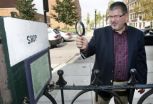(Press-News.org) This press release is available in Spanish.
The goal of the scientists in the Information and Communications Technology Security Group (Seguridad de las Tecnologías de la Información y las Comunicaciones - SeTI) at UC3M who are working on the E-SAVE project is to use information technologies (ITs) to improve the enforcement of certain traffic regulations. Specifically, they propose a set of systems for the automated, immediate and telematic supervision and management of the administrative sanctioning process. The purpose is to reduce highway accidents, given that one of the critical factors in doing so consists in improving the enforcement of traffic regulations.
The basis on which the researchers have designed their proposal lies within the area known as "Intelligent Transport Systems". These include the recent advances in the area of processing and transmitting information, as well as in the perception capabilities of motor vehicles, which come equipped with an ever-increasing number of sensors. Along these lines, they have developed various protocols and mechanisms where information security and the protection of privacy are critical, indispensable elements. This research has been published in Intelligent Transport Systems.
First, they have designed a mechanism that allows victims to report offenders, while guaranteeing the authenticity, confidentiality and integrity of the information. Second, they have proposed a mechanism for sending the notification of a fine directly to the offending vehicle, with the intention of increasing the immediacy of the process (because the sanction can be presented to the offender while s/he is still driving), thus increasing its educational effectiveness. In the third place, in order to insure the driver's right to adequate means of defending her/himself when faced with supposedly unfair sanctions, a protocol for creating evidence that describes recent driving behavior has been proposed. In this way, the driver would increase her/his ability to defend her/himself if s/he receives a fine s/he does not agree with. "The supposed offender would have a mechanism to create electronic evidence of her/his driving behavior. How? Basically, by asking the surrounding vehicles to act as electronic witnesses," explains José María de Fuentes, of UC3M's Computer Science Department.
Experimental evaluation
In the coming months, the researchers plan to begin the experimental evaluation of the proposed mechanisms, for which they will use communication devices that are specifically designed for communication between vehicles and infrastructure. Thanks to this capability, they plan to test a secure means of providing information to the driver. To do this, they are proposing a mechanism that would avoid the distribution of false information regarding traffic events and incidents via the vehicular communication network.
The SeTI group at UC3M is also working on improving the automatic verification of the vehicle and driver's documentation as part of the project known as PRECIOUS. "It is important that verification does not allow us to be traced, that is to say, that we cannot be followed; therefore our approach is based on the use of cryptographic techniques of anonymous authentification, zero knowledge tests, etc.," says the researcher. To do this, they have proposed a model of credentials that are electronically implemented, eliminating the redundancy and duplication of information that exist with current systems. In this way, it will be possible to authenticate credentials in a much more efficient manner.
###The E-SAVE project (Arquitectura de Seguridad y Generación de Pruebas Electrónicas Forenses en Entornos Vehiculares -) is funded through the Plan Nacional de I+D+i 2008-2011 del Ministerio de Ciencia e Innovación (the Science and Innovation Ministry's National R+Di Plan for 2008 – 2011), while the PRECIOUS project (Privacidad Responsable en la Circulación de Vehículos – Responsible Privacy in Vehicular Traffic) is funded by the Autonomous Community of Madrid's 2011 grant competition. In both cases – in the hopes of having a positive impact on road safety – the team is proposing systems for the supervision and automated, immediate and telematic management of certain aspects of traffic: the administrative sanctioning system, in the case of E-SAVE, and the private verification of the authorizations required for driving, in the case of PRECIOUS.
Further information:
Towards an automatic enforcement for speeding: enhanced model and intelligent transportation systems realisation
Authors: J.M. de Fuentes A.I. González-Tablas J.L. Hernández-Ardieta A. Ribagorda
Source: INTELLIGENT TRANSPORT SYSTEMS. Volume: 6. Number: 3. Page: 270-281. Published in September 2012. ISSN: 1751-956X
A system to automate traffic fines is designed
2012-10-09
ELSE PRESS RELEASES FROM THIS DATE:
Researchers develop new way to determine amount of charge remaining in battery
2012-10-09
Researchers from North Carolina State University have developed a new technique that allows users to better determine the amount of charge remaining in a battery in real time. That's good news for electric vehicle drivers, since it gives them a better idea of when their car may run out of juice.
The research is also good news for battery developers. "This improved accuracy will also give us additional insight into the dynamics of the battery, which we can use to develop techniques that will lead to more efficient battery management," says Dr. Mo-Yuen Chow, a professor ...
UC research finds small signs lead to big frustrations
2012-10-09
Signs that are too small or unclear to consumers seem to be a growing national issue, leading some business owners to lose potential customers, according to University of Cincinnati Marketing Professor James Kellaris.
"This persistent, growing national problem is frustrating for consumers and can lead to loss of business and, by extension, loss of tax revenue for the community," Kellaris said.
Kellaris, the James S. Womack/Gemini Chair of Signage and Visual Marketing in the UC Carl H. Lindner College of Business, will present this research during the October 10 -11 ...
Cause of annoyance, concern, anxiety, and even anger:
2012-10-09
To understand the effects of continuous computerized surveillance on individuals, a Finnish research group instrumented ten Finnish households with video cameras, microphones, and logging software for personal computers, wireless networks, smartphones, TVs, and DVDs. The twelve participants filled monthly questionnaires to report on stress levels and were interviewed at six and twelve months. The study was carried out by Helsinki Institute for Information Technology HIIT, a joint research institute of Aalto University and the University of Helsinki, Finland.
The results ...
Southampton researchers explain how pulsars slow down with age
2012-10-09
Researchers at the University of Southampton have developed a model which explains how the spin of a pulsar slows down as the star gets older.
A pulsar is a highly magnetised rotating neutron star which was formed from the remains of a supernova – an explosion which happens after a massive star runs out of nuclear fuel. A pulsar emits a rotating beam of electromagnetic radiation, rather like that of a lighthouse. This beam can be detected by powerful telescopes when it points towards and sweeps past the Earth.
Pulsars rotate at very stable speeds, but slow down as ...
Researchers examine how teachers can increase students' interest and engagement in the classroom
2012-10-09
The National Center for Educational Statistics reported that only 73% of high school freshmen graduate within four years. For those students who continue their education at the collegiate level, slightly more than half (57%) earn a bachelor's degree and over 18% will leave college altogether. Although many factors can contribute to students' academic risk, negative emotions associated with learning—such as a lack of interest and engagement in their courses—could be a vital reason for students' disengagement, withdrawal, and failure in school.
Joseph Mazer's article, published ...
Making computer data storage cheaper and easier
2012-10-09
Businesses and consumers may soon have a simple, cheaper way to store large amounts of digital data.
Case Western Reserve University researchers have developed technology aimed at making an optical disc that holds 1 to 2 terabytes of data – the equivalent of 1,000 to 2,000 copies of Encyclopedia Britannica. The entire print collection of the Library of Congress could fit on five to 10 discs.
The discs would provide small- and medium-sized businesses an alternative to storing data on energy-wasting magnetic disks or cumbersome magnetic tapes, the researchers say. To ...
Demographic miracle in the deserts
2012-10-09
This press release is available in German.
Using demographic methods, ecologist Roberto Salguero-Gómez investigates desert plants to find out how vulnerable they are to climate change. The results of his newest study are surprising: Climate change may have a positive impact on some plants.
Climate models used by scientists to forecast the effect of climate change on the various ecosystems predict a bleak future for these regions: temperatures will rise, there will be less rain, and it will rain more erratically – all conditions seemingly unfavorable to plants.
To ...
Putting a block on neuropathic pain before it starts
2012-10-09
Boston, Mass.—Using tiny spheres filled with an anesthetic derived from a shellfish toxin, researchers at Boston Children's Hospital and the Massachusetts Institute of Technology have developed a way to delay the rise of neuropathic pain, a chronic form of pain that arises from flawed signals transmitted by damaged nerves.
The method could potentially allow doctors to stop the cascade of events by which tissue or nerve injuries evolve into neuropathic pain, which affects 3.75 million children and adults in the United States alone.
The researchers, led by Daniel Kohane, ...
Curb kids' screen time to stave off major health and developmental problems
2012-10-09
In the face of mounting evidence, doctors' leaders and government should take a stand and set clear guidelines on an activity that has so far eluded the scrutiny that other health issues attract, argues Dr Aric Sigman.
Children of all ages are watching more screen media than ever before, he says, and what is more, they are starting earlier and earlier.
Britain's children have regular access to an average of five different screens at home by the time they are 10 years old, in the form of TVs, games consoles, smart phones, laptops and tablets.
By the age of 7, a child ...
Cannabis extract eases muscle stiffness typical of multiple sclerosis
2012-10-09
Up to 90 per cent of MS patients endure painful muscle stiffness at some point during the course of their disease, which reduces their mobility and interferes with daily routine activities and sleep quality. But current treatments often fail to resolve symptoms fully, and can be harmful, as a result of which many MS patients have experimented with alternative therapies, including cannabis.
Adult MS patients with stable disease, from 22 different specialist centres across the UK, were either randomly assigned to cannabis extract (tetrahydrocannabinol) daily (144) or a ...

